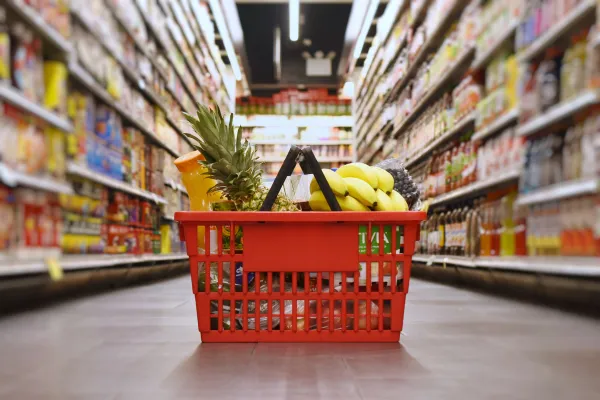Memos to Myself: Notes for Future Ben
Memos to Myself:
Notes for Future Ben
Musings, Observations, Lessons, and Insights to Look Back On

Food vs Food Products
Dear Reader:
I believe that wellness begins with what we put in our bodies. For my own reasons - I’ve spent years digging into nutrition, trying things out, and figuring out what works. I’ve changed my mind a million times, changed my diet more than once, and found more bad information than anyone should ever read. But as I look out at the health crises in America, where we lose our loved ones earlier and spend most our lives on prescription drugs, it's clearer than ever that the we must eat to live and not live to eat.
Yes, this is one of those articles that will tell you to eat healthy...
So, let’s chat about the wild world of food and food products, shall we?
Food vs Food Products
Real Talk on Real Food
Alright, picture this: you’re in the grocery store, and there are two worlds in front of you – the world of actual food and the world of, well, food-ish products. It’s like a game show, but the prize is your health.
The real food? That’s your fruits, veggies, and bulk items.
The other stuff? That’s the aisles filled with boxes, bags, and cans.
And here’s the kicker: the confusion between these two worlds is messing with our health, big time.
Real food nourishes us and provides energy, while food products deplete us and, usually, require a nap after we eat. That's because food products are filled with highly-processed ingredients, flavorings, dyes, and other chemical compounds. These take work for our bodies to break down, and some never quite do.
Don’t Fall for the Fancy Packaging
Let’s get one thing straight – the food industry is pretty darn good at making food products look like the real deal. Bright colors, catchy slogans, and promises of happiness right there in the box. But remember, it’s a trap.
Those sugary snacks and processed foods might taste good in the moment, but they’re setting us up for a lifetime of medical bills, prescription medications, and doctor’s visits.
It’s a harsh reality, but it’s one we need to face head-on. We need to see through the marketing smoke and mirrors and understand that true happiness and health can’t be found in a box or a bag.
Learning the art of label reading and ingredient investigating is like having a superpower in the grocery store. And mastering it is easier than you think.
If you can't pronounce an ingredient, it's probably not something you should consume. At least not without a quick Google search first.
You do have your phone with you, don't you? Use it!
Choosing Wisely
Alright, let’s get down to the nitty-gritty of making smart choices in the grocery store. This isn't about a specific diet plan or following a trend, because, at the end of the day, anyone telling you to follow one is probably just trying to make a sale...
It’s crucial to have your own game plan and set of rules about what’s cool and what’s not before you step into the dazzling, somewhat surreal world of the grocery store.
Once you’re there, it’s all about hunting down the real food and steering clear of those sneaky food products. It's generally best to stick to whole foods and bulk items: fruits, vegetables, grains, legumes, nuts, and seeds.
Now, you might be wondering, “What about foods that used to be real but now they’re...kind of not?” I’m looking at you, dear jam. The key here is to search for foods with a one-ingredient list when possible (and spoiler alert: that ingredient should not be sugar!)
It’s a jungle out there, but together, we’re going to navigate it and fill our carts with the good stuff, right?
Not All Food is Created Equal
Modern Farming: A Double-Edged Sword
Food in its birthday suit (you know, natural) is usually a good choice. But here’s the deal: not all “natural” food is living up to its potential. Modern farming is doing a number on the quality of our food.
And while organic and high-quality options might make our wallets thinner, hospital bills and meds to fix a bad diet are a whole lot pricier.
GMOs and Pesticides
Genetically modified what-now? Pesticides everywhere?
If you’re scratching your head, you’re not alone...
Genetically modified organisms, or GMOs for short, might sound like something out of a sci-fi movie, but they’re very much a part of our current food landscape. And pesticides? Well, they’re practically everywhere.
Now, you might be wondering, why on earth are we playing around with the DNA of our food? It’s a valid question, and one that deserves some serious thought. The intention behind GMOs is often to make crops more resistant to pests and diseases, but it’s worth pondering what the long-term effects might be on our health and the environment.
And then there’s pesticides. They’re designed to keep the bugs away, sure, but if they’re lethal to pests, it’s only natural to wonder what they’re doing to our bodies when we consume them, especially our gut microbiome. It’s a topic that’s been debated by scientists and health experts alike, and it’s something we should all be paying close attention to.
Plenty of industry-funded studies tell us GMOs and pesticides are fine...that's trustworthy, right?
Seedless Fruits and Funky Juices
Now, let’s talk about something a bit peculiar: seedless fruits and those juices that smell like they belong in a perfume bottle rather than on your breakfast table. Ever noticed that? It’s strange, right?
Fruits are supposed to have seeds. That’s how nature intended it. But somewhere along the way, we decided we’d rather not deal with the hassle of spitting out seeds, and seedless varieties started popping up everywhere. It’s convenient, sure, but it’s also a bit bizarre when you stop and think about it.
And then there are the juices. Some of them smell so sweet and artificial, you have to wonder what exactly is being added to them. It’s like walking through a department store perfume section rather than sipping on something that came from a fruit. Maybe they need a little boost because juices from concentrate are highly processed, loaded with sweeteners and other additives. Yum.
These are just a few of the little oddities in our food supply that deserve a second glance. It’s all part of being a conscious consumer and understanding what’s really on our plates and in our glasses. So, let’s keep our eyes peeled, ask questions, and make sure we know what we’re putting into our bodies.
When in Doubt, Go Whole and Organic
Whole Foods for the Win
Let’s take a moment to really appreciate the unsung heroes of the food world: whole foods. Imagine a league of superheroes, each with their own unique powers, coming together to fight the good fight for our health. Fruits, veggies, grains, legumes, nuts, and seeds – these are the warriors we need on our side.
These whole foods come to us from nature with their nutrients intact, not stripped away or altered. They’re real, they’re unprocessed, and they’re bursting with goodness. And the best part? You can base your entire diet around these food groups, getting close to 100% of your nutritional needs met by these natural powerhouses.
Think about the energy, the vitality, and the sheer joy that comes from feeding your body the best of the best. It’s like giving yourself a daily dose of superhero strength, ready to tackle whatever life throws your way.
Worth the Hype?
Organic. It’s been the buzzword in the food world for a while now, and it’s time to really dig into what it means and why it matters. Organic foods are grown without synthetic pesticides, without GMOs, and with a whole lot of love and care for the environment.
Yes, they can come with a higher price tag, but let’s weigh the pros and cons here...
On one hand, you have a slightly lighter wallet.
On the other, you have a body that’s being nourished by the cleanest, purest foods available. You’re avoiding a cocktail of chemicals, and you’re supporting farming practices that are kinder to our planet.
But hey, I get it. We're all on a budget here.
Organic food isn’t just a trend; it’s a return to a more natural and sustainable way of farming and eating. It’s about reconnecting with our food, understanding where it comes from, and appreciating the process it takes to get to our plates.
When you choose organic, you’re casting a vote. You’re saying yes to biodiversity, yes to soil health, and yes to a future where our food is grown responsibly and sustainably. You’re supporting farmers who are brave enough to step away from conventional practices, who are dedicated to providing us with food that’s as close to nature as possible.
And sure, the price tag can be daunting. But the cost of not choosing organic? That’s even scarier. We’re talking about the long-term impact on our health, the soil, the water, and the air. We’re talking about the legacy we leave for future generations.
So, while our wallets might feel the pinch, our bodies and our planet will thank us. Because choosing organic isn’t just about eating well; it’s about making a conscious choice to care for ourselves and the world around us.
And in the end, that’s a price worth paying.
The Hard Part
Junk Food’s Siren Call
Let’s dive a bit deeper, shall we? Have you ever noticed how just thinking about a juicy burger or a sugary donut can make your mouth water? Why are we drawn to that bag of chips and chocolate bar so hard? That’s dopamine, my dear reader – our brain’s pleasure chemical. And oh boy, does junk food know how to get that dopamine pumping.
Think about it. Just the mere thought of biting into a gooey piece of pizza or a rich, chocolate brownie can send our brains into a frenzy. That’s dopamine working its magic, convincing us that yes, we do need that sugary or fatty treat. But here’s the rub: while we’re basking in the momentary bliss of that junk food, our health is taking a hit. We’re packing on the pounds, our energy levels are plummeting, and our risk for chronic diseases is skyrocketing.
It’s a cruel irony, really. We eat for pleasure, seeking that dopamine high, but what we’re left with is a body that’s begging for a break. It’s a cycle that’s as vicious as they come, and breaking free from it requires more than just willpower.
The Sensory Overload
Stepping into a grocery store can feel like walking into a war zone. There are choices at every turn, colors vying for our attention, and the constant battle between what we want and what we need. It’s sensory overload at its finest, and it can leave us feeling overwhelmed and defeated.
But here’s the thing: we have the power to navigate this jungle. We have the knowledge to make informed choices and the strength to resist the siren call of junk food. It’s about tuning into our bodies, listening to what they truly need, and filling our carts with foods that nourish rather than deplete.
Savoring the Good Stuff
So, how do we break free from the dopamine dilemma and the marketing maze? How do we find our way through the grocery store jungle and come out on the other side, victorious and healthy? How do we choose food instead of food products? The answer, my dear reader, is mindful eating.
Mindful eating is about slowing down, savoring each bite, and truly experiencing the flavors, textures, and smells of our (real) food. It’s about making conscious choices, understanding the impact our choices make on our bodies, and finding joy in the act of preparing fresh foods and in natural eating habits.
We must transform our relationship with food to lead ourselves toward a life of health, happiness, and true pleasure. Embrace mindful eating, savor the good stuff, and let’s eat to live, not live to eat.
Because in the end, our health is worth it.
Smarter Choices
Stepping into the grocery store, armed with knowledge and a discerning perspective, transforms what could be an overwhelming experience into a journey of empowerment. You now have the tools to differentiate between the real food and the deceptive food products, to see beyond the flashy packaging, and to make choices that truly nourish your body.
Remember, this is not just about a single meal or a fleeting trend; it's about cultivating a sustainable lifestyle that supports your long-term well-being. It's about embracing whole foods, understanding the implications of modern farming, and considering the benefits of organic options. It's about being mindful of the dopamine-driven desires for junk food and recognizing the manipulative tactics of food marketing.
So, as you navigate the aisles, fill your cart with confidence. Choose fruits, vegetables, grains, legumes, nuts, and seeds. Opt for organic when possible, and don’t be swayed by the allure of processed food products.
Ask questions, stay curious, and trust your newfound knowledge.
Here’s to making smarter choices, to eating real food, and to feeling genuinely awesome...
Deo volente.
PS. If you want to want more information about wellness - join our free Facebook group: https://www.facebook.com/groups/mindandbodywellnessgroup






